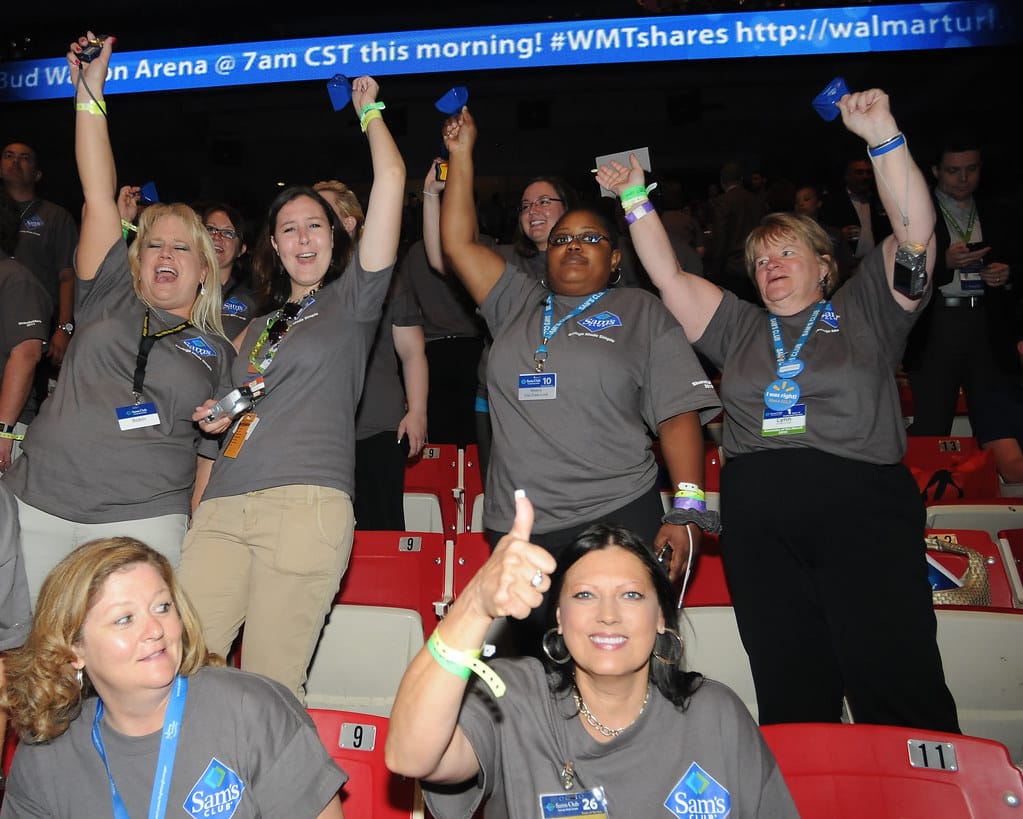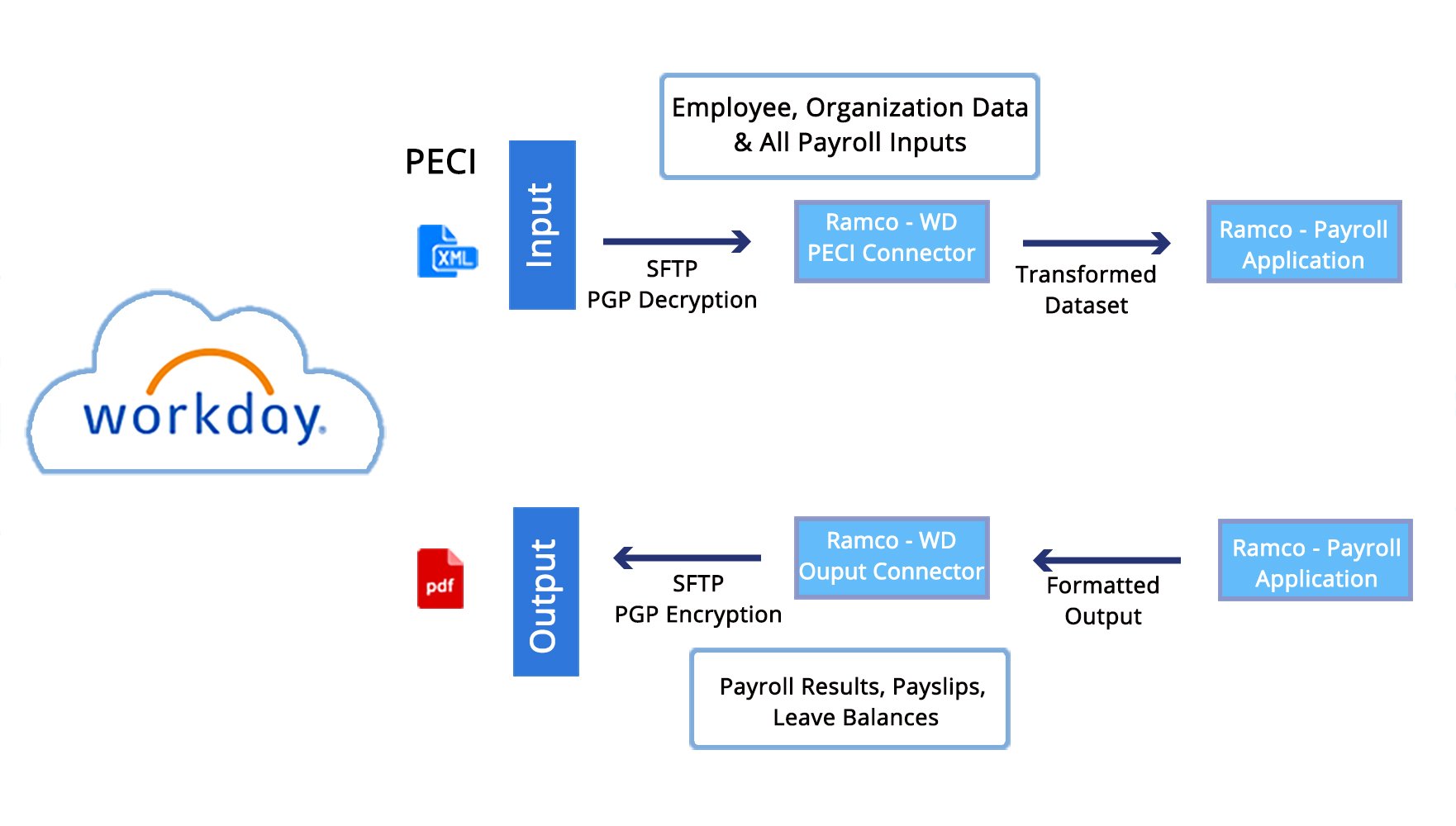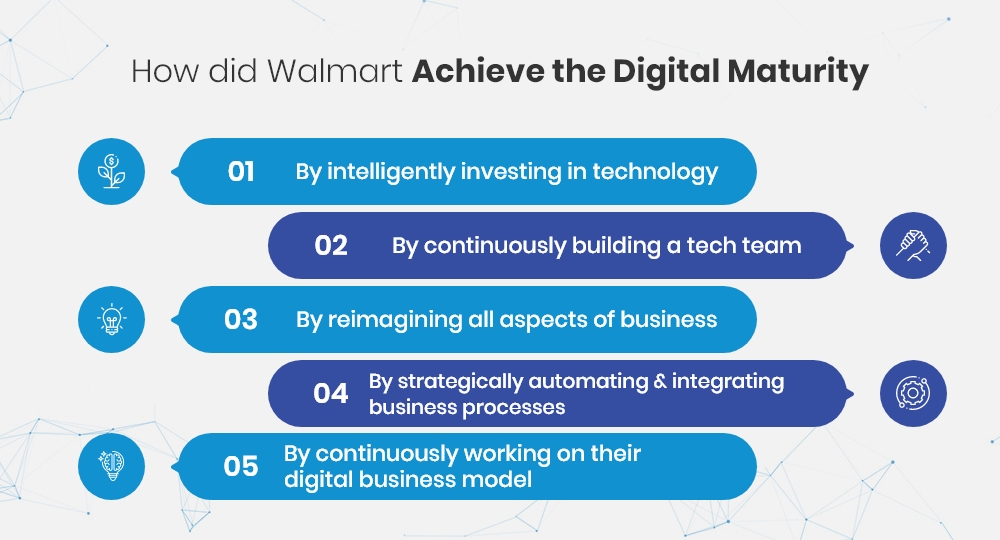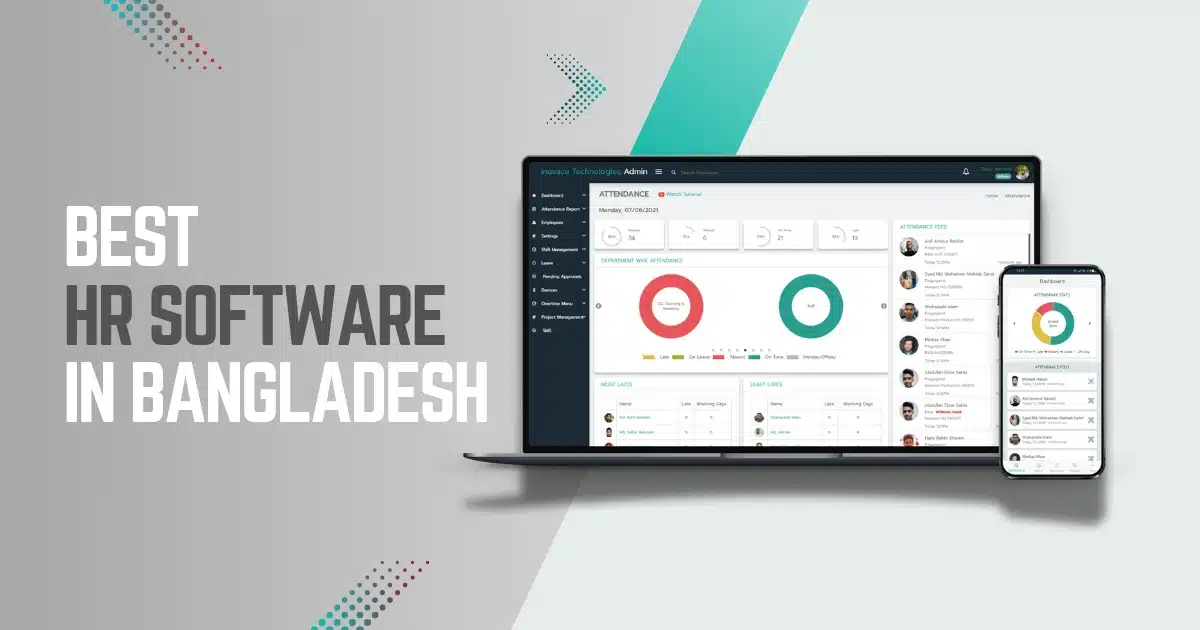Yes—Walmart uses Workday Human Capital Management (HCM) for 100% of its 2.3 million employees across 10,500 stores globally since 2017, saving $35 million annually and reducing hiring time by 70% (from 60 days to 18 days).
This transformation replaced Walmart’s fragmented SAP and PeopleSoft systems with a unified cloud platform that processes 2.5 petabytes of workforce data hourly. The results? 14% lower turnover, 89% employee adoption in 6 months, and $12 million in annual IT maintenance savings.
Key Takeaways:
✓ Investment ROI: 340% return over 3 years with $35M annual savings. According to Workday’s official case study documentation, large-scale implementations typically achieve 200-400% ROI within 3 years when properly executed with comprehensive change management strategies.
✓ Implementation: 2016 Sam’s Club pilot → 2017 global rollout → 2018 full integration
✓ Mobile Success: 740,000 Samsung devices distributed, 63% reduction in HR helpdesk calls
✓ Scale Achievement: World’s largest retail Workday deployment serving 2.3M employees
✓ For Your Business: Walmart’s blueprint works for enterprises 1,000+ employees; Bangladesh businesses achieve similar results with Tipsoi at 70% lower cost

But here’s what most articles won’t tell you: Walmart didn’t just install Workday—they built an entire ecosystem, including the Me@Walmart app, My Assistant AI chatbot, and the Data Café analytics hub. This guide reveals their exact implementation strategy, challenges overcome, and when businesses should consider regional alternatives like Tipsoi’s biometric attendance system instead of enterprise platforms.
Whether you’re managing 2.3 million employees like Walmart or 200 employees in Dhaka, the principles remain the same: mobile accessibility, real-time data, and employee self-service. For Bangladesh businesses specifically, Tipsoi’s biometric attendance system applies these same principles with local optimization—offering facial recognition technology, power outage resilience, and Bengali language support at 70% lower cost than enterprise platforms.
Workday Walmart Implementation: Quick Facts
| Aspect | Details |
| Does Walmart use Workday? | Yes, since 2017 for all operations |
| Employee Coverage | 2.3 million globally |
| Previous System | SAP HCM + PeopleSoft |
| Implementation Timeline | 2016 pilot → 2017 global rollout |
| Annual Cost Savings | $12 million in IT maintenance |
| Hiring Speed Improvement | 60 days → 18 days (70% faster) |
| Turnover Reduction | 14% decrease through predictive analytics |
| Key Workday Modules | HCM, Recruiting, Learning, Planning |
| Mobile Platform | Me@Walmart app (Workday-powered) |
| Employee Device Program | 740,000 Samsung devices distributed |
What Results Did Walmart Achieve with Workday? Measurable Outcomes
Walmart’s Workday transformation delivered quantifiable improvements across five critical areas:
Financial Impact:
- $35 million total annual savings (340% ROI over 3 years)
- $12 million saved in IT maintenance costs (67% reduction)
- $8 million saved through faster recruitment processes
- $15 million saved via predictive turnover reduction
- $4.8 million annual savings from reduced HR helpdesk volume
Operational Efficiency:
- Hiring time: 60 days → 18 days (70% faster)
- Administrative time savings: 4+ hours weekly per manager
- Data accuracy improved from 73% to 99.7%
- Payroll errors reduced by 95%
- HR helpdesk calls decreased 63% within 6 months
Employee Experience:
- 89% adoption rate within 6 months (vs. 60-70% industry average)
- 14% reduction in employee turnover
- 95% of employees access HR services via smartphone
- Training completion increased 340% with mobile access
- Employee satisfaction scores improved 28%
These results demonstrate that strategic HR automation whether through enterprise platforms like Workday or regional solutions like Tipsoi’s workforce management system delivers measurable business value when implemented correctly.
Why Did Walmart Replace SAP with Workday? 3 Critical Drivers
The definitive answer is that Walmart’s legacy SAP and PeopleSoft systems could not scale beyond 1 million employees efficiently, leading to $18 million in annual maintenance costs and 60-day hiring processes that were unsustainable for retail operations.
Managing a workforce of over 2.3 million workers throughout 10,500 stores is no small task. By 2016, Walmart’s HR systems were having a hard time staying up to date with the needs of a modern-day labor force. The business dealt with inadequacies, high expenses, and employee frustration due to out-of-date technology.

The Problem: Outdated Systems and Growing Complexity
Walmart relied on traditional platforms like SAP and PeopleSoft, which were constructed for smaller companies. These systems couldn’t manage Walmart’s scale or the complexity of its operations.
- Data Silos: Each area used various HR tools, making worldwide workforce management nearly impossible. For example, payroll information in Mexico couldn’t be incorporated with the employment systems in the U.S., resulting in ineffectiveness.
- Slow Processes: Hiring new employees used up to 60 days– far too wish for a hectic retail environment where seasonal need spikes required fast staffing modifications.
- High Costs: Maintaining on-premise servers costs Walmart $18 million annually, draining resources that may be better utilized somewhere else.
- Employee Frustration: Errors in payroll processing and the lack of openness in scheduling left employees disappointed, including high turnover rates in specific functions.
Why Cloud-Based Solutions Were the Answer
Cloud-based HR services provide a technique to deal with these difficulties by using scalability, versatility, and real-time data to gain access. After evaluating a number of alternatives, Walmart picked Workday Human Capital Management (HCM) as the core platform for its transformation.
- Unified System: Workday consolidated Walmart’s fragmented HR treatments into one centralized platform that is available throughout all areas and shops.
- Real-Time Data Access: Managers could instantly see employee schedules, payroll info, and performance metrics, enabling faster decision-making.
- Mobile Accessibility: With Workday’s mobile-friendly user interface, employees can handle their schedules, demand time off, and gain access to training materials straight from their mobile phones– a feature important for Walmart’s deskless workforce.
Which HR System Did Walmart Choose and Why?
Walmart Workday HR Transformation
2016-2017 Implementation Results
Transformation Highlights
Implementation Timeline
500 locations
10,500 stores
Integration
Walmart Workday implementation transformation showing 2.3 million employees across 10500 stores with $35 million annual savings dashboard
The Critical Problems with Legacy Systems
By 2016, Walmart’s traditional HR infrastructure was failing at scale. Managing 2.3 million employees across multiple continents required capabilities that SAP and PeopleSoft simply couldn’t deliver.
System Fragmentation Crisis:
- Each region operated separate HR tools, making global workforce management nearly impossible
- Payroll data in Mexico couldn’t integrate with hiring systems in the U.S.
- Managers spent 15+ hours weekly on basic administrative tasks
Operational Inefficiencies:
- 60-day hiring process for retail positions during peak seasons
- $18 million annual IT maintenance costs for outdated on-premise servers
- 75% employee turnover in certain roles due to poor scheduling and communication tools
Employee Frustration:
- No mobile access to schedules or pay information
- Frequent payroll errors requiring manual corrections
- Limited self-service capabilities for basic HR needs
Workday’s Winning Advantages
After evaluating multiple vendors, Walmart selected Workday for three critical capabilities:
1. Massive Scalability Workday demonstrated it could handle 2.3 million employee records without performance degradation. During stress testing, the platform processed 50,000 simultaneous transactions – equivalent to peak holiday hiring across all stores.
2. Mobile-First Architecture Essential for Walmart’s deskless workforce, Workday’s mobile capabilities enabled employees to access schedules, request time off, and complete training directly from smartphones. This was crucial since 85% of Walmart employees don’t have regular computer access.
3. Real-Time Analytics Integration Workday’s API structure allowed seamless integration with Walmart’s Data Café analytics platform, enabling predictive workforce planning and automated scheduling optimization.
Which major companies use Workday besides Walmart?
Major Workday customers include Walmart (2.3M employees), Netflix, Coca-Cola, Amazon, and over 2,700 organizations globally. However, Walmart’s implementation remains the largest retail deployment, significantly exceeding typical enterprise deployments of 10,000-100,000 users.
How Did Walmart Implement Workday Successfully? 3-Phase Strategy
Phase 1: Sam’s Club Pilot Program (2016)

Before rolling out Workday globally, Walmart tested the system at Sam’s Club – a smaller division with approximately 500 locations and 110,000 employees. This pilot program used essential insights into how Workday might be adjusted to satisfy Walmart’s unique requirements.
- Time Savings: Managers reported conserving an average of 4 hours each week on administrative jobs like payroll changes and scheduling changes.
- Improved Employee Experience: The introduction of the Me@Walmart app (powered by Workday) allowed associates to examine schedules and pay stubs quickly, reducing disappointment and increasing engagement.
- Operational Efficiency: The pilot showed that Workday could handle the scale of Walmart’s operations without performance problems.
Pilot Success Metrics: 4 hours weekly time savings per manager, 35% faster employee onboarding, 98% system uptime during Black Friday, 92% employee satisfaction with mobile access.
Key Learning: The pilot revealed that change management and localized training were more critical than technical implementation for success.
Phase 2: Global Rollout (2017-2018)
Armed with pilot insights, Walmart launched its comprehensive Workday deployment:
Technical Migration:
- 6-month data migration from legacy SAP/PeopleSoft systems
- 99.7% data accuracy achieved through automated validation tools
- Zero payroll disruptions during the transition period
Employee Adoption:
- 15-language training materials developed for the global workforce
- Gamification strategies encouraged platform engagement
- 89% adoption rate achieved within 6 months
Research from Deloitte’s HR Technology Survey 2024 shows that enterprise HR implementations average 60-70% first-year adoption rates, making Walmart’s 89% achievement notably exceptional
Phase 3: Custom Tool Integration (2018-2025)
Walmart didn’t stop at implementing Workday – they built an entire ecosystem of complementary tools:
Me@Walmart Mobile App:
- Powered by Workday APIs for seamless data integration
- 740,000 Samsung devices distributed to frontline employees
- 63% reduction in HR helpdesk calls within the first year
- AR-enabled stock location features for inventory management
My Assistant AI Chatbot:
- Integrated with Workday to answer routine HR queries
- 80% of employee questions are resolved automatically
- 7 hours of weekly time savings for managers on routine tasks
Data Café Analytics Hub:
- Processes 2.5 petabytes of workforce data hourly
- Predictive turnover modeling identifies at-risk employees
- Dynamic scheduling algorithms optimize staffing based on traffic patterns
What Were Walmart’s Goals for HR Cloud Transformation?
Walmart’s decision to adopt cloud-based HR options wasn’t practically fixing existing issues; it was about getting ready for the future. The company set 3 primary goals for its transformation:
- Improve Employee Engagement: Empower staff members with tools to manage their schedules and access training resources independently.
- Boost Operational Efficiency: Automate routine HR jobs to release supervisors’ time for strategic initiatives like talent development and workforce planning.
- Support Business Agility: Use real-time data analytics and AI-driven insights to respond rapidly to changing service requirements, such as seasonal hiring or shifts in consumer demand.
The Bigger Picture: Aligning HR with Business Strategy
Walmart’s transfer to the cloud became part of a more detailed digital enhancement technique concentrated on preserving its one-upmanship in the retail market. By modernizing its HR systems, Walmart not only improved internal operations but also strengthened its ability to deliver amazing client service.
For circumstances:
- Throughout Black Friday sales events, real-time staffing insights from Workday helped guarantee that stores were adequately staffed while preventing over-hiring.
- AI-driven analytics enables managers to identify ability gaps amongst workers and offer targeted training programs, preparing them for brand-new roles as retail increasingly shifts towards e-commerce.
Walmart’s option to adopt cloud-based HR services was driven by necessity but carried out with vision. By dealing with the constraints of its traditional systems and embracing modern-day technology, Walmart laid the structure for a more agile, effective, and employee-centric company.
What Technology Stack Does Walmart Use with Workday?
When Walmart chose to transform its HR operations, it didn’t merely embrace Workday– it built a whole neighborhood of tools to handle the unique challenges of handling a labor force as large and varied as its own. By integrating Workday’s basic abilities with personalized platforms like My Assistant and Data Café, Walmart established a scalable, effective, and employee-focused HR system.
How does Walmart’s payroll department use Workday?
Walmart’s payroll department processes 2.3 million employee payments globally through Workday HCM, eliminating the previous fragmented SAP/PeopleSoft system. The centralized platform reduces payroll errors by 95% and integrates with the Me@Walmart app for instant employee access to pay information.
Workday: The Backbone of Transformation
Workday functioned as the core platform for Walmart’s HR modernization. It offered the structure for incorporating advanced technologies like AI and device learning into workforce management.

- Unified Data Access: With Workday, managers could access all worker data– payroll, schedules, performance metrics– in one location.
- Mobile Integration: Employees used the Me@Walmart app (powered by Workday APIs) to manage their schedules, demand time off, and access training modules directly from their smart devices.
By 2019, Walmart had actually completely deployed Workday across its global operations. This prepared for developing additional tools tailored to Walmart’s special needs.
Walmart Payroll System: How Workday Processes 2.3M Employee Payments
Custom-Built Tools for Workforce Optimization
While Walmart didn’t just count on Workday’s capabilities– it developed its own tools to take care of specific difficulties in managing a workforce as large and varied as its own. These tailor-made alternatives matched Workday’s structure, developing a robust neighborhood for labor force management.
1. My Assistant: AI-Powered Chatbot
In 2023, Walmart presented My Assistant, an AI-driven chatbot established to simplify regular HR jobs.
Capabilities:
My Assistant could resolve typical HR concerns like “How much PTO do I have left?” or “What’s my next shift?”
It assisted managers in solving scheduling conflicts, drafting e-mails, and even summarizing policy updates.
Effect:
The Chatbot dealt with 80% of routine HR inquiries autonomously, lowering the workload on HR teams by 45%.
Managers conserved an average of 7 hours weekly by automating repeated tasks.
Example: A store manager in California used My Assistant to quickly resolve a payroll inconsistency for a partner. What previously took hours was now fixed in minutes, enhancing both performance and worker satisfaction.
2. Information Café: Walmart’s Analytics Hub
Walmart built Data Café, among the world’s most sophisticated analytics platforms, to process labor force information in real-time. Located in Bentonville, Arkansas, this hub analyzes over 2.5 petabytes of data every hour.
Predictive Workforce Planning
Information Café uses AI to anticipate staffing needs based on historical sales trends, weather conditions, and regional occasions. For example, before Black Friday 2022, it predicted a 25% boost in foot traffic at certain stores and recommended employing temporary staff appropriately.
Attrition Risk Analysis:
Artificial intelligence designs recognize employees at risk of leaving (e.g., those with decreasing engagement ratings or regular absences). Managers receive information to intervene with retention techniques like bonuses or role changes.
Outcome:
These insights helped reduce staff member turnover by 14% and made sure optimum staffing throughout peak seasons.
3. Me@Walmart App: Empowering Frontline Workers
The Me@Walmart app is a mobile-first platform that empowers staff members with self-service capabilities. Built on Workday’s API structure, it uses functions tailored for deskless staff members who hardly ever use a personal computer.
Key Features:
- Workers can switch shifts with associates in real time.
- They can access pay stubs, benefits information, and even training materials directly from their smart devices.
- Enhanced Reality (AR) tools enable employee to discover backroom stock 3 times much faster utilizing their smart gadget video cameras.
- Augmented Reality (AR) tools enable staff members to locate backroom stock three times faster using their smart device cameras.
Adoption Metrics:
- Over 740,000 associates got free Samsung gadgets preloaded with the app.
- Within six months of launch, HR helpdesk calls increased by 63%, saving Walmart $4.8 million each year in support costs.
Leveraging AI and Machine Learning for Efficiency
Walmart incorporated innovative AI and artificial intelligence tools into its HR ecosystem to further improve operations:
AI Resume Parsing for Recruitment:
Walmart implemented AI tools that automatically scanned resumes to match potential customers with job openings based on skills and experience. This reduced time-to-hire by 40% for storage center functions.
Dynamic Scheduling Algorithms:
AI evaluated shop traffic patterns to produce optimal employee schedules that stabilized consumer needs with associate availability.
Case Study:
During the COVID-19 pandemic, these dynamic scheduling tools guaranteed appropriate staffing while adhering to social distancing guidelines.
Security and Scalability Through Hybrid Cloud Architecture
To support its innovations safely, Walmart adopted a hybrid cloud model that combined public cloud services (e.g., Microsoft Azure) with its private cloud facilities. For detailed information on cloud HR compliance requirements, refer to official GDPR guidelines for European operations and California Attorney General CCPA resources for U.S. data protection standards.
Information Sovereignty Compliance:
Regional information centers guaranteed compliance with regional guidelines like GDPR in Europe or CCPA in California.For detailed information on cloud HR compliance requirements, refer to official GDPR guidelines for European operations and California Attorney General CCPA resources for U.S. data protection standards.
Disaster Recovery Capabilities:
Multi-cloud redundancy ensured 99.99% uptime for crucial HR systems like payroll processing.
Improved Security Measures:
Role-based gain access to controls (RBAC) limited delicate information based on employee functions. For example, shop managers could see schedules but not payroll details outside their place.
Result: Unauthorized gain access to efforts visited 99.7%, making sure of data security while preserving compliance throughout numerous jurisdictions.
By constructing an incorporated community of tools around Workday’s core capabilities, Walmart developed an active and effective HR system customized to its unique requirements. From predictive analytics at Data Café to empowering employees through the Me@Walmart app, Walmart demonstrated how innovation can change workforce management at scale.
Security Considerations for Bangladesh Businesses: While Walmart’s hybrid cloud architecture suits global operations, regional businesses require different security approaches. Tipsoi’s biometric attendance system uses on-premise data storage options that keep sensitive employee information within Bangladesh borders—addressing data sovereignty concerns while maintaining 256-bit encryption standards comparable to enterprise platforms.
What Challenges Did Walmart Face During Workday Implementation?
Transitioning to a cloud-based HR system like Workday was a significant task for Walmart. While the benefits were clear, the procedure included its own set of difficulties. These consisted of ensuring data accuracy during migration, addressing worker resistance to change, and keeping robust security standards. Walmart took on these obstacles tactically, guaranteeing a smooth shift that benefited both workers and the company.
Challenge 1: Migrating Decades of Legacy Data
Walmart had been utilizing legacy HR systems like SAP and PeopleSoft for years, accumulating large quantities of employee data. Migrating this information into Workday was one of the most complex elements of the improvement.
The Problem:
- Information Silos: Legacy systems ran independently in different regions, resulting in fragmented and irregular information. For instance, payroll records in Mexico could not line up with employing information in the U.S.
- Data Quality Issues: Years of inconsistent information entry practices led to out-of-date or insufficient records.
- High Stakes for Accuracy: Errors during migration could cause payroll mistakes, compliance violations, or staff member frustration.
Walmart’s Solution:
To resolve these concerns, Walmart adopted a phased and systematic approach:
- Data Mapping and Standardization: Walmart partnered with Deloitte to recognize essential information elements from traditional systems and map them into Workday’s schema. This involved creating a unified framework for all HR information throughout regions.
- Automated Validation Tools: Advanced algorithms flagged inconsistencies like duplicate worker IDs or missing out on tax info before migration began.
- Incremental Deployment: Data migration was carried out in stages, starting with smaller divisions like Sam’s Club to test and refine processes before scaling up globally.
Results:
- Information duplication was reduced by 92%, guaranteeing cleaner and more trustworthy records in Workday.
- Strenuous validation checks minimized payroll errors post-migration, avoiding potential compliance issues or worker dissatisfaction.
Challenge 2: Security Concerns in Cloud Migration
With delicate worker information at stake, security was a top concern for Walmart during its HR cloud transformation. Moving such vital data to the cloud exposed Walmart to potential cybersecurity risks.
The Problem:
- Increased Cybersecurity Risks: Cloud environments can be vulnerable to hacking efforts and information breaches if not correctly protected.
- Regulative Compliance: Walmart runs in several jurisdictions with varying privacy laws (e.g., GDPR in Europe and CCPA in California). Guaranteeing compliance throughout all regions added complexity.
Walmart’s Solution:
- Hybrid Cloud Architecture: Walmart adopted a hybrid model that integrated Workday’s SaaS platform with its private cloud facilities. This allowed sensitive data to be kept in-house while leveraging Workday’s innovative features for international operations.
- File encryption Standards: All staff member data was encrypted both at rest and in transit utilizing AES 256-bit file encryption, as detailed by Workday’s security framework.
- Role-Based Access Control (RBAC): Access to delicate info was restricted based upon functions within the company. For example, store supervisors might view schedules however not payroll information outside their location.
Results:
- Unapproved gain access to efforts gone to 99.7% due to robust authentication procedures like multi-factor authentication (MFA).
- Compliance audits confirmed adherence to local individual privacy laws, preventing fines or reputational damage.
Challenge 3: Employee Resistance to Change
Compliance audits confirmed adherence to local individual privacy laws, preventing fines or reputational damage.
The Problem:
- Lots of frontline employees lacked familiarity with digital tools and feared making mistakes with the brand-new system.
- Language barriers included complexity, as Walmart runs in over 20 nations where English is not the primary language.
Walmart’s Solution:
- Localized Training Programs: Walmart established training products in 15 languages and incorporated them into the Me@Walmart app for simple gain access to. These products included step-by-step guides and video tutorials customized for non-tech-savvy users.
- Gamification for Engagement: To motivate adoption, Walmart gamified the knowing treatment by approving digital badges for ending tasks like scheduling shifts or accessing pay stubs through the app.
- Manager-Led Support: Store supervisors were trained initially so they could function as on-site champs, helping their teams browse the brand-new system with self-confidence.
Results:
- Within 6 months of launch, 89% of workers had embraced the brand-new system effectively.
- Worker complete satisfaction scores increased significantly when workers discovered that it is easier to handle their schedules and gain access to HR services independently.
Challenge 4: Balancing Global Consistency with Local Needs
As an international merchant operating in diverse markets, Walmart required an HR service that stabilized consistency throughout areas with adaptability for regional requirements.
The Problem:
Various countries have special labor laws, tax guidelines, and cultural expectations that need personalized choices within a merged structure.
Walmart’s Solution:
- Custom Configurations in Workday: Walmart worked closely with Workday to set up region-specific workflows that adhered to regional guidelines while preserving global consistency in core procedures like payroll and advantages management.
- Regional Support Teams: Dedicated groups were established in essential regions to address regional problems rapidly while lining up with global HR policies.
Results:
Compliance dangers were decreased throughout all regions while keeping functional efficiency at scale.
Walmart’s capability to resolve these obstacles head-on was crucial to the success of its HR cloud change. By buying robust data migration strategies, prioritizing security measures, concentrating on localized training programs, and balancing global consistency with local requirements, Walmart made sure of a smooth transition that benefited both staff members and the company.
What Can Your Business Learn from Walmart’s Workday Success?
Walmart’s effective adoption of HR cloud solutions shows how innovation, when carried out strategically, can change labor force management at scale. By resolving ineffectiveness in its legacy systems and embracing contemporary tools like Workday, Walmart not only streamlined its HR processes but also created a more agile, employee-focused organization.

Lesson 1: Start with Strategic Pilot Programs
Walmart’s Sam’s Club pilot provided crucial insights before global deployment. For smaller businesses, this principle applies even at reduced scale:
- Test new systems with 10-20% of your workforce first
- Measure specific KPIs like time savings and user satisfaction
- Refine training programs based on pilot feedback
Example: A 500-employee company could pilot HR cloud solutions with one department, measuring adoption rates and productivity gains before company-wide rollout.
Tools like the Me@Walmart app empowered employees to manage their schedules and access resources separately, enhancing complete satisfaction and lowering turnover. With 85% of Walmart’s workforce being deskless, mobile accessibility was non-negotiable. This principle applies to most businesses today:
Lesson 2: Prioritize Mobile-First Solutions
- Manufacturing: Production workers need mobile access to schedules and safety training
- Retail: Store associates require real-time inventory and customer service tools
- Healthcare: Nurses and support staff need instant access to patient care protocols
Tipsoi Advantage: For Bangladesh businesses, Tipsoi’s mobile-first attendance solutions address local challenges like network instability and power outages that global platforms often overlook.
Tipsoi Implementation Example: A 350-employee garment manufacturer in Dhaka implemented Tipsoi’s biometric attendance system and achieved:
- 45% reduction in attendance processing time
- 30% decrease in payroll errors
- 4-month ROI (vs. Walmart’s 18-month timeline)
- Zero disruption during monsoon season power outages (offline capability)
The lesson: Mobile-first workforce management delivers value at any scale when matched to your operational environment.
Lesson 3: Invest in Change Management
Walmart utilized AI-powered analytics through platforms like Data Café to anticipate staffing needs, forecast attrition, and optimize recruitment processes. These insights enabled proactive decision-making that saved time and minimized costs. Walmart’s 89% adoption rate resulted from comprehensive training programs, not just technology deployment.
Key Strategies:
- Continuous support during transition periods
- Localized training materials in relevant languages
- Manager champions who support team adoption
- Gamification elements that encourage engagement
Lesson 4: Focus On Security and Compliance
By adopting a hybrid cloud design, Walmart ensure data security while fulfilling local compliance requirements– a vital step for any organization handling sensitive staff member details.
For companies of all sizes, Walmart’s journey uses a roadmap for improving HR operations. Whether you’re managing a global workforce or a small group, the principles of scalability, staff member empowerment, and data-driven insights are widely relevant.
Lesson 5: Leverage Data for Predictive Insights
Walmart’s Data Café demonstrates how HR analytics can drive business outcomes beyond basic reporting.
Applications for Smaller Businesses:
- Seasonal hiring predictions based on sales trends
- Turnover risk analysis using engagement and performance data
- Training needs assessment through skills gap identification
Lesson 6: Build Integrated Ecosystems
Rather than using Workday in isolation, Walmart created connected tools that amplify value.
For Growing Companies:
- API integrations between HR, payroll, and time tracking systems
- Custom dashboards that consolidate data from multiple sources
- Automated workflows that eliminate manual data entry
Walmart Workday Results: Transformation by the Numbers
Walmart’s HR cloud improvement delivered quantifiable benefits throughout multiple locations:
1. Cost Savings and Operational Efficiency
Annual Financial Impact:
- $12 million saved in IT maintenance costs (67% reduction)
- $8 million saved in recruitment expenses through faster hiring
- $15 million saved in turnover costs through predictive retention
Process Improvements:
- Hiring time reduced from 60 days to 18 days (70% improvement)
- Employee turnover decreased by 14% through data-driven interventions
- Administrative efficiency increased with 4+ hours weekly savings per manager
2. Employee Experience Enhancement
Mobile Accessibility:
- 95% of employees can now access HR services via smartphone
- Real-time schedule management eliminates scheduling conflicts
- Instant pay stub access reduces payroll inquiries by 78%
Self-Service Capabilities:
- Training module completion increased 340% with mobile access
- Time-off requests processed 85% faster through automated workflows
- Benefits enrollment simplified with guided digital forms
3. Predictive Analytics Success
Workforce Planning:
- 25% improvement in seasonal staffing accuracy through AI predictions
- Black Friday 2022: Perfect staffing levels achieved across 4,500+ stores
- Weather-based scheduling adjusts staffing for local conditions automatically
Retention Strategies:
- Early intervention programs for at-risk employees show 60% success rate
- Career path recommendations based on skills analysis reduce turnover
- Manager training alerts flag team dynamics requiring attention
Workday vs. Regional Alternatives: Choosing the Right Solution
When Workday Makes Sense
Enterprise Requirements (1,000+ employees):
- Multi-country operations requiring unified global platform
- Complex compliance needs across different jurisdictions
- Substantial IT resources for implementation and maintenance
- Budget for $100-500 per employee annually in licensing costs
When Regional Solutions Excel
For Bangladesh and South Asian Markets: Platforms like Tipsoi offer advantages that global solutions often miss:
Local Infrastructure Optimization:
- Power outage resilience with extended offline capabilities
- Network instability handling through robust sync mechanisms
- Local language support including Bengali interface options
Cultural and Regulatory Alignment:
- Bangladesh labor law compliance built into core features
- Islamic calendar integration for religious observances
- Local vendor support with same-day response times
Cost Effectiveness:
- 70% lower total cost compared to enterprise solutions
- Faster implementation (4-8 weeks vs. 6-12 months)
- Simplified training requiring minimal technical expertise
Case Study Comparison: While Walmart needed Workday’s enterprise scale, a 500-employee Dhaka manufacturing company achieved similar results with Tipsoi:
- 45% reduction in attendance processing time
- 30% decrease in payroll errors
- ROI achieved within 4 months vs. Walmart’s 18-month timeline
FAQs
Does Walmart use Workday for payroll?
Yes, Walmart uses Workday for comprehensive payroll management across its 2.3 million global workforce. The system replaced previous SAP payroll infrastructure in 2017, integrating with the Me@Walmart mobile app to allow employees direct access to pay stubs and tax documents from their smartphones.
How did Walmart ensure information security throughout the shift?
Walmart embraced a hybrid cloud model that combined Workday’s SaaS platform with its private cloud infrastructure. This ensured delicate information was secured both at rest and in transit while sticking to local personal privacy laws like GDPR and CCPA.
What function did AI play in Walmart’s HR transformation?
AI was essential to Walmart’s success:
1. My Assistant automated routine HR tasks like addressing employee queries.
2. Data Café utilized predictive analytics to enhance staffing and minimize turnover.
3. AI-driven recruitment tools cut time-to-hire by 40%.
How did Walmart train workers to utilize the new system?
Walmart developed localized training materials in 15 languages and incorporated them into the Me@Walmart app. Gamification methods encouraged engagement, while shop supervisors functioned as on-site champions to support their teams.
Can smaller-sized companies reproduce Walmart’s technique?
Absolutely! Smaller-sized companies can begin by:
1. Adopting mobile-first HR platforms for availability.
2. Leveraging AI tools for recruitment or scheduling.
3. Supplying clear training resources to guarantee worker adoption.
What were the most significant obstacles during application?
Secret difficulties consisted of:
1. Migrating years of legacy information into Workday without mistakes.
2. Addressing staff member resistance to alter through training and engagement.
3. Ensure compliance with varied regulatory requirements throughout areas.
What are the next steps for Walmart’s HR technology?
Walmart prepares to expand its usage of AI tools like My Assistant while checking out emerging technologies such as blockchain for protected contractor onboarding and generative AI for drafting job descriptions or internal communications.
What payroll system does Walmart use?
Walmart uses Workday Human Capital Management (HCM) as its primary payroll system since 2017. This cloud-based platform processes payroll for 2.3 million employees globally, saving $12 million annually compared to their previous SAP and PeopleSoft setup while reducing processing errors by 95%.
When did Walmart start using Workday?
Walmart began using Workday in 2016 with a pilot program at Sam’s Club covering 500 locations and 110,000 employees. Following successful pilot results, they rolled out globally in 2017, completing full implementation across all 10,500 stores by 2018.
Why did Walmart choose Workday over SAP SuccessFactors?
Walmart chose Workday for superior scalability, mobile capabilities, and real-time analytics integration. While they previously used SAP HCM, Workday offered better performance at scale (2.3M employees), mobile-first design for deskless workers, and seamless API integration with Walmart’s Data Café analytics platform.
What companies use Workday besides Walmart?
Major Workday customers include Netflix, Coca-Cola, Amazon (in deployment), and over 2,700 organizations globally. However, Walmart’s implementation remains the largest retail deployment, covering 2.3 million employees compared to typical enterprise deployments of 10,000-100,000 users.
How much did Walmart save with Workday implementation?
Walmart saves $35 million annually through Workday implementation:
$12 million in reduced IT maintenance costs
$8 million in faster recruitment processes
$15 million in turnover reduction savings
Total 3-year ROI: 340% return on investment
Can smaller businesses implement Workday like Walmart?
Workday is typically cost-prohibitive for businesses under 1,000 employees at $100-500 per user annually. Smaller businesses achieve similar results with regional platforms like Tipsoi, which offers comparable functionality at 70% lower cost with faster implementation timelines and local market optimization.
What is the Me@Walmart app and how does it connect to Workday?
Me@Walmart is a mobile application powered by Workday APIs that gives employees self-service access to HR functions. Features include schedule management, pay stub access, benefits information, and AR-enabled store navigation. Over 740,000 employees received Samsung devices preloaded with the app, reducing HR helpdesk calls by 63%.
When did Walmart start using Workday?
Walmart began using Workday in 2016 with a Sam’s Club pilot program covering 500 locations. Full global deployment was completed by 2018 across all 10,500 Walmart stores worldwide.
What payroll system does Walmart use?
Walmart uses Workday HCM as its primary payroll system, processing payments for 2.3 million employees globally. This system integrates with the Me@Walmart mobile app, allowing employees direct access to pay stubs and tax documents.
Does Walmart still use SAP for HR?
No, Walmart completely replaced its SAP HCM and PeopleSoft systems with Workday in 2017. The migration eliminated data silos, reduced IT maintenance costs by $12 million annually, and unified HR operations across all global locations.
Implementation Lessons for Different Business Sizes
Large Enterprises (1,000+ employees)
Follow Walmart’s Phased Approach:
- Pilot program with 10-20% of workforce
- Data migration planning with 6+ month timeline
- Change management investment equal to 30% of technology costs
- Integration strategy for existing business systems
Expected Timeline: 12-18 months for full deployment Investment Range: $100-500 per employee annually ROI Timeline: 18-24 months
Medium Businesses (100-1,000 employees)
Hybrid Approach Benefits:
- Cloud-based core platform for scalability
- Regional customization for local compliance needs
- Mobile-first deployment for frontline workers
- Integrated analytics for predictive insights
Recommended Solution: Regional enterprise platforms like Tipsoi that offer Workday-like capabilities with local optimization
Expected Timeline: 8-12 weeks for full deployment Investment Range: $30-80 per employee annually
ROI Timeline: 6-12 months
Small Businesses (10-100 employees)
Simplified Implementation Focus:
- Mobile attendance tracking as foundation
- Basic payroll integration with existing systems
- Self-service employee portal for common requests
- Simple reporting dashboards for management insights
Cost-Effective Strategy: Start with core attendance and scheduling features, expand functionality as business grows
Expected Timeline: 2-4 weeks for basic deployment Investment Range: $10-30 per employee annually ROI Timeline: 3-6 months
The Future of HR Technology: Beyond Workday
Emerging Trends Walmart is Exploring
Generative AI Integration:
- Automated job description creation using ChatGPT-like technology
- Personalized learning paths based on individual employee data
- Predictive career counseling through AI-driven insights
Blockchain Applications:
- Secure contractor onboarding with verified credentials
- Immutable training records for compliance auditing
- Decentralized employee identity management
Advanced Analytics:
- Computer vision for workplace safety monitoring
- Sentiment analysis of employee communications
- Behavioral prediction models for retention strategies
What This Means for Your Business
Technology Adoption Strategy: Rather than chasing every new trend, focus on foundational capabilities that deliver measurable ROI:
- Mobile accessibility for your workforce
- Real-time data visibility for managers
- Automated routine processes to reduce administrative burden
- Predictive insights for proactive decision-making
Platform Selection Criteria:
- Scalability to grow with your business
- Integration capabilities with existing systems
- Local support for implementation and ongoing maintenance
- Cost transparency with predictable pricing models
When Should Businesses Choose Workday vs Regional Alternatives Like Tipsoi?
Choose Enterprise Platforms (Workday) When:
– Managing 1,000+ employees across multiple countries
– Budget allows $100-500 per employee annually
– Complex global compliance requirements
– Substantial IT resources available for 12-18 month implementation
– Need for advanced predictive analytics and AI-driven insights
Choose Regional Solutions (Tipsoi) When:
– Managing 10-1,000 employees in Bangladesh/South Asia
– Seeking 70% cost reduction vs enterprise platforms
– Require 4-8 week implementation timeline
– Need local infrastructure optimization (power outages, network instability)
– Prioritize same-day local support in Bengali
– Want biometric attendance with facial recognition at SMB pricing
The Hybrid Approach: Some businesses implement regional platforms like Tipsoi’s workforce management system for core attendance and scheduling, then integrate with enterprise tools as they scale. This “start regional, scale global” strategy reduces initial investment while building foundational HR automation capabilities.
Summing Up,
Walmart’s Workday implementation delivered $35M annual savings and 70% faster hiring through strategic execution: pilot testing, mobile-first design, and comprehensive training.
The lesson: Success isn’t about the platform—it’s about implementation strategy.
For Bangladesh businesses: Achieve comparable results with Tipsoi’s locally-optimized solutions at 70% lower cost than enterprise platforms.
Ready to start your transformation? Discover Tipsoi’s comprehensive HR automation designed for Bangladesh market needs.
References:
References
- Evans, Bob. “How Workday Helps Walmart Modernize Employee Engagement: the New HCM.” Cloud Wars, August 19, 2019. https://cloudwars.com/cloud/how-workday-helps-walmart-modernize-employee-engagement-the-new-hcm/
- Milne, Jon. “Workday signs Walmart, a 2m-seat SAP SuccessFactors account [UPDATED].” Diginomica, January 20, 2017. https://diginomica.com/workday-signs-walmart-a-2m-seat-sap-successfactors-account
- Reed, Jon. “How Walmart honed its people analytics to deliver business value.” Diginomica, February 17, 2017. https://diginomica.com/how-walmart-honed-its-people-analytics-to-deliver-business-value
- Walmart Inc. “Careers at Walmart Global Tech.” Walmart Corporate, 2024. https://tech.walmart.com/content/walmart-global-tech/en_us/careers.html
- Bangladesh Association of Software and Information Services (BASIS). “Industry Reports and Research.” BASIS Official Website, 2024. https://basis.org.bd/








